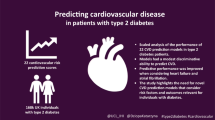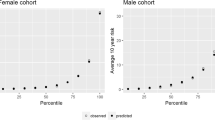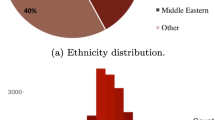Abstract
Background and Objective
Many guidelines for clinical decisions are hierarchical and nonlinear. Evaluating if these guidelines are used in practice requires methods that can identify such structures and thresholds. Classification and regression trees (CART) were used to analyse prescribing patterns of Australian general practitioners (GPs) for the primary prevention of cardiovascular disease (CVD). Our aim was to identify if GPs use absolute risk (AR) guidelines in favour of individual risk factors to inform their prescribing decisions of lipid-lowering medications.
Methods
We employed administrative prescribing information that is linked to patient-level data from a clinical assessment and patient survey (the AusHeart Study), and assessed prescribing of lipid-lowering medications over a 12-month period for patients (n = 1903) who were not using such medications prior to recruitment. CART models were developed to explain prescribing practice. Out-of-sample performance was evaluated using receiver operating characteristic (ROC) curves, and optimised via pruning.
Results
We found that individual risk factors (low-density lipoprotein, diabetes, triglycerides and a history of CVD), GP-estimated rather than Framingham AR, and sociodemographic factors (household income, education) were the predominant drivers of GP prescribing. However, sociodemographic factors and some individual risk factors (triglycerides and CVD history) only become relevant for patients with a particular profile of other risk factors. The ROC area under the curve was 0.63 (95 % confidence interval [CI] 0.60–0.64).
Conclusions
There is little evidence that AR guidelines recommended by the National Heart Foundation and National Vascular Disease Prevention Alliance, or conditional individual risk eligibility guidelines from the Pharmaceutical Benefits Scheme, are adopted in prescribing practice. The hierarchy of conditional relationships between risk factors and socioeconomic factors identified by CART provides new insights into prescribing decisions. Overall, CART is a useful addition to the analyst’s toolkit when investigating healthcare decisions.


Similar content being viewed by others
Notes
Prior exposure to medication is not preferred as we would observe risk factors after response to treatment.
This has been shown to be an optimal method for model selection [29].
This identifies all the nodes where the predictor is selected, sums the improvement in classification from each of these and divides by the number of tree branches [28].
Bagging or ‘bootstrapped aggregating’ is a method for generating multiple versions of a tree to allow evaluation of predictor stability [31].
For example, there is some evidence to suggest that compliance increases with the number of risk factors [45].
References
Bonner C, et al. General practitioners’ use of different cardiovascular risk assessment strategies: a qualitative study. Med J Aust. 2013;199(7):485–9.
Jansen J, et al. General practitioners’ use of absolute risk versus individual risk factors in cardiovascular disease prevention: an experimental study. BMJ Open. 2014;4(5):e004812.
Greenland P, et al. 2010 ACCF/AHA guideline for assessment of cardiovascular risk in asymptomatic adults: a report of the American College of Cardiology Foundation/American Heart Association Task Force on Practice Guidelines developed in collaboration with the American Society of Echocardiography, American Society of Nuclear Cardiology, Society of Atherosclerosis Imaging and Prevention, Society for Cardiovascular Angiography and Interventions, Society of Cardiovascular Computed Tomography, and Society for Cardiovascular Magnetic Resonance. J Am Coll Cardiol. 2010;56(25):e50–103.
Stone NJ, et al. 2013 ACC/AHA guideline on the treatment of blood cholesterol to reduce atherosclerotic cardiovascular risk in adults: a report of the American College of Cardiology/American Heart Association Task Force on Practice Guidelines. J Am Coll Cardiol. 2014;63(25 Pt B):2889–934.
Lalor E, et al. National Vascular Disease Prevention Alliance. Guidelines for the management of absolute cardiovascular disease risk. 2012. ISBN 978–0–9872830–1–6. https://strokefoundation.com.au/~/media/strokewebsite/resources/treatment/absolutecvd_gl_webready.ashx?la=en.
National Heart Foundation of Australia. Guide to management of hypertension 2008. 2010. Available at: http://www.heartfoundation.org.au/SiteCollectionDocuments/HypertensionGuidelines2008to2010Update.pdf.
Heeley EL, et al. Cardiovascular risk perception and evidence-practice gaps in Australian general practice (the AusHEART study). Med J Aust. 2010;192(5):254–9.
Razavian M, et al. Cardiovascular risk management in chronic kidney disease in general practice (the AusHEART study). Nephrol Dial Transpl. 2012;27(4):1396–402.
Zwar N, et al. GPs’ views of absolute cardiovascular risk and its role in primary prevention. Aust Fam Physician. 2005;34(6):503–4.
Varian HR. Big data: new tricks for econometrics. J Econ Perspect. 2014;28(2):3–27.
Knott RJ, et al. How fair is Medicare? The income-related distribution of Medicare benefits with special focus on chronic care items. Med J Aust. 2012;197:625–30.
Knott RJ, et al. The effects of reduced copayments on discontinuation and adherence failure to statin medication in Australia. Health Policy. 2015;119(5):620–7.
Hothorn T, et al. Party: a laboratory for recursive partytioning. 2010. Available at: https://cran.r-project.org/web/packages/party/vignettes/party.pdf.
Drakopoulos SA. Hierarchical choice in economics. J Econ Surv. 1994;8(2):133–53.
Scott A. Identifying and analysing dominant preferences in discrete choice experiments: an application in health care. J Econ Psychol. 2002;23(3):383–98.
Pharmaceutical Benefits Scheme. General statement for lipid-lowering drugs prescribed as pharmaceutical benefits. Pharmaceutical Benefits Scheme; 2014.
Garg AX, et al. Effects of computerized clinical decision support systems on practitioner performance and patient outcomes: a systematic review. JAMA. 2005;293(10):1223–38.
Berthold H, et al. Patterns and predictors of statin prescription in patients with type 2 diabetes. Cardiovasc Diabetol. 2009;8(1):25.
Wong M, et al. Patterns of antihypertensive prescribing, discontinuation and switching among a Hong Kong Chinese population from over one million prescriptions. J Hum Hypertens. 2008;22(10):714–6.
Timofeev R. Classification and regression trees (CART) theory and applications. Humboldt-Universitat zu Berlin, Wirtschaftswissenschaftliche Fakultat. 2004. http://edoc.hu-berlin.de/docviews/abstract.php?id=26951.
Tomcikova D, et al. Epidemiology, quality improvement and outcome: risk of in-hospital mortality identified according to the typology of patients with acute heart failure: classification tree analysis on data from the Acute Heart Failure Database–main registry. J Crit Care. 2013;28:250–8.
Navarro Mdel C, et al. Discriminative ability of heel quantitative ultrasound in postmenopausal women with prevalent vertebral fractures: application of optimal threshold cutoff values using classification and regression tree models. Calcif Tissue Int. 2012;91(2):114–20.
Shi K-Q, et al. Risk stratification of spontaneous bacterial peritonitis in cirrhosis with ascites based on classification and regression tree analysis. Mol Biol Rep. 2012;39(5):6161–9.
Breiman L, et al. Classification and regression trees. Boca Raton: CRC Press; 1984.
Torgo L. Inductive learning of tree-based regression models. Universidada do Porto. Reitoria. 1999. http://repositorio-aberto.up.pt/handle/10216/10018.
Briand B, et al. A similarity measure to assess the stability of classification trees. Comput Stat Data Anal. 2009;53(4):1208–17.
Mohammed MA, El Sayed C, Marshall T. Patient and other factors influencing the prescribing of cardiovascular prevention therapy in the general practice setting with and without nurse assessment. Med Decis Making. 2012;32(3):498–506.
The Mathworks Inc. Matlab and statistics toolbox release 2015a. Natick: The Mathworks; 2015.
Kohavi R. A study of cross-validation and bootstrap for accuracy estimation and model selection. IJCAI. 1995;2:1137–43.
Kitsantas P, Hollander M, Li LM. Assessing the stability of classification trees using Florida birth data. J Stat Plan Inference. 2007;137(12):3917–29.
Breiman L. Bagging predictors. Mach Learn. 1996;24(2):123–40.
Dannegger F. Tree stability diagnostics and some remedies for instability. Stat Med. 2000;19(4):475–91.
Strobl C, Malley J, Tutz G. An introduction to recursive partitioning: rationale, application, and characteristics of classification and regression trees, bagging, and random forests. Psychol Methods. 2009;14(4):323.
Lopert R, Henry D. The Pharmaceutical Benefits Scheme: economic evaluation works… but is not a panacea. Aust Prescr. 2002;25(6):126.
French SD, et al. Evaluation of a theory-informed implementation intervention for the management of acute low back pain in general medical practice: the IMPLEMENT cluster randomised trial. PLoS One. 2013;8(6):e65471.
McKenzie JE, et al. Evidence-based care of older people with suspected cognitive impairment in general practice: protocol for the IRIS cluster randomised trial. Implement Sci. 2013;8(1):91.
McKenzie JE, et al. Improving the care for people with acute low-back pain by allied health professionals (the ALIGN trial): a cluster randomised trial protocol. Implement Sci. 2010;5(1):86.
Allen D, Harkins KJ. Too much guidance? Lancet. 2005;365(9473):1768.
Prevedello LM, et al. Does clinical decision support reduce unwarranted variation in yield of CT pulmonary angiogram? Am J Med. 2013;126(11):975–81.
Cholesterol Treatment Trialists’ (CTT) Collaborators. Efficacy and safety of cholesterol-lowering treatment: prospective meta-analysis of data from 90,056 participants in 14 randomised trials of statins. Lancet. 2005;366(9493):1267–78.
Kearney P, et al. Efficacy of cholesterol-lowering therapy in 18,686 people with diabetes in 14 randomised trials of statins: a meta-analysis. Lancet. 2008;371(9607):117–25.
Ashworth M, et al. Social deprivation and statin prescribing: a cross-sectional analysis using data from the new UK general practitioner ‘Quality and Outcomes Framework’. J Public Health (Oxf). 2007;29(1):40–7.
Weitoft GR, et al. Education and drug use in Sweden—a nationwide register-based study. Pharmacoepidemiol Drug Saf. 2008;17(10):1020–8.
Heeley E, et al. Disparities between prescribing of secondary prevention therapies for stroke and coronary artery disease in general practice. Int J Stroke. 2012;7(8):649–54.
Latry P, et al. Adherence with statins in a real-life setting is better when associated cardiovascular risk factors increase: a cohort study. BMC Cardiovasc Disord. 2011;11(1):46.
Field CA, Welsh AH. Bootstrapping clustered data. J R Stat Soc Series B Stat Methodol. 2007;69(3):369–90.
Acknowledgments
This work was supported by Monash University, the George Institute for Global Health, and the University of Melbourne.
Chris Schilling, Duncan Mortimer, Kim Dalziel, Emma Heeley, John Chalmers and Philip Clarke declare that they have no conflicts of interest.
Author contributions
CS, DM and KD conceptualized this report. All authors had input in developing the approach. CS produced multiple drafts. All authors provided input on the draft report and all read and approved the final report.
Author information
Authors and Affiliations
Corresponding author
Appendices
Appendix 1
See Table 4.
Appendix 2
After condensing the data to obtain a single observation per patient, our CART makes no further adjustment for clustering of observations by GP. On average, GPs see eight patients within the dataset (minimum of one patient per GP; maximum of 16). Stability across bagged trees may be overestimated if ‘bags’ of observations are drawn from clustered data. In supplementary analyses, we evaluated stability of the CART in 100 samples drawn using cluster-bootstrap methods [46]. Predictor counts and threshold densities were much the same with the cluster bootstrap as for the simple bootstrap on clustered data described above.
Similarly, while detailed contextual data on each GP was not available, the data did contain a State location variable that identifies the GP’s geographic region. In supplementary analyses, we included this variable within the predictor set, however it did not enter into the preferred CART model shown in Fig. 1.
Rights and permissions
About this article
Cite this article
Schilling, C., Mortimer, D., Dalziel, K. et al. Using Classification and Regression Trees (CART) to Identify Prescribing Thresholds for Cardiovascular Disease. PharmacoEconomics 34, 195–205 (2016). https://doi.org/10.1007/s40273-015-0342-3
Published:
Issue Date:
DOI: https://doi.org/10.1007/s40273-015-0342-3




